Wet blocking is a process used to finish articles made from yarn. It basically involves soaking your finished piece of knitting or crochet to wet it thoroughly then shaping it to the final dimensions, pinning it into place, and leaving it to dry. When dry, the piece will hold its new dimensions (until you wash it, in which case it’ll need to be blocked again while it dries).
Why Wet Block?
Pretty much everything can benefit from blocking, to even up your stitches and square up the edges. But, for lacy projects, blocking is essential for opening up the stitches and showing off the stitch pattern.
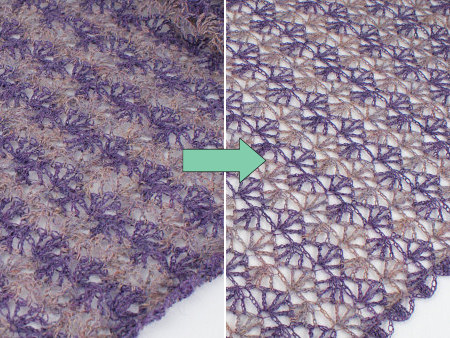
My Rippled Lace Rectangular Shawl before and after blocking – there’s no comparison!
You’ll find wet blocking instructions in all my crocheted lace PlanetJune Accessories patterns, but I thought it might be helpful to go into a bit more detail here – I’ll explain how to wet block, the best tools for blocking, and some clever money-saving substitutions (also useful if you don’t have a local shop that sells the specialised blocking tools).
Basic Wet Blocking Instructions
- Soak your piece in lukewarm water until thoroughly saturated.
- Gently squeeze without wringing, to remove most of the water.
- Lay out on a clean towel and roll the towel up to remove excess moisture.
- Lay out onto your blocking surface (foam floor tiles, or a large dry towel on a flat surface).
- Gently ease into shape, using a tape measure to make sure the piece is shaped symmetrically or achieves the required dimensions.
- Use blocking wires and/or pins to keep in position while it dries.
- When completely dry (typically about 24 hours), remove the pins and/or wires.
Wet Blocking Tools
The minimum requirements for blocking are:
- A towel to remove excess moisture
- Towel(s) large enough to lay out your project onto
- A surface you can pin into (a bed, carpet)
- Rustproof pins
But, with a couple more purchases, your blocking will be much easier and more successful. The magic tools are:
- Blocking wires
- Foam floor tiles
Blocking wires are a revelation! Any time you need to wet block a crocheted (or knit) piece with straight edges, they save so much time and make a straight edge much easier to achieve. When you stretch a wet piece to block it and pin it into shape while it dries, the fabric between each pin tends to be stretched less, and you end up with a slightly scalloped edge, where each pinned point is stretched out more than the area between pins. You can minimise this by increasing the number of pins you use, but that takes a lot of pins, and a lot of time. If you weave a blocking wire along an entire straight edge of a piece, you need only a few pins to keep the wire in position, and the final edge will be perfectly straight. This is especially crucial for lace projects.
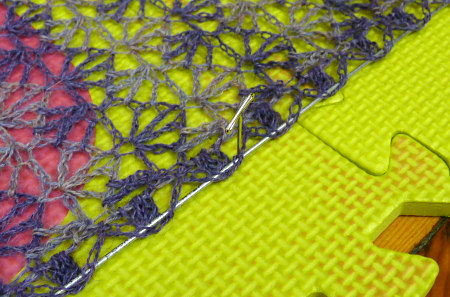
The blocking wire keeps the entire edge perfectly straight with very few pins
Foam floor tiles are waterproof and make a perfect surface for pinning into – especially if you don’t have a spare bed or carpeted floor to leave your work pinned to for 24-48 hours! The interlocking edges allow you to create a surface as large as you like, anywhere you have room for them.
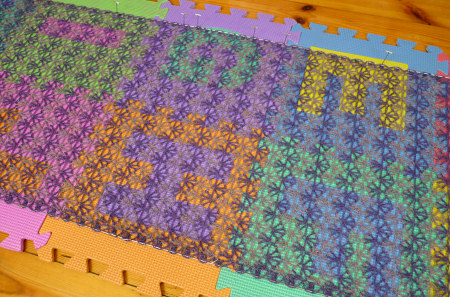
Foam floor tiles are the perfect waterproof surface to pin into
Money-saving Tips
You can buy all these from yarn shops, for example KnitPicks sell reasonably-priced foam Blocking Mats ($25), Lace Blocking Wires ($20), and T Pins ($3). But you can save even more money by looking for the same products in everyday shops (this is also helpful if you don’t have access to a yarn store that sells dedicated blocking supplies). Here are my top tips:
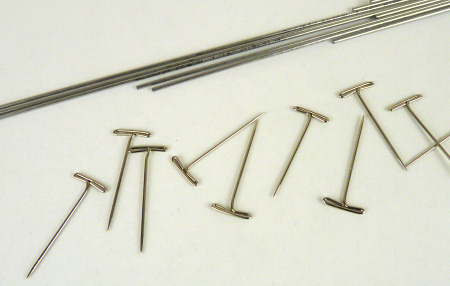
Blocking wires (welding wires) and T pins
Stainless steel welding wires are identical to blocking wires, and you get over twice as many for about the same cost – so split a pack with a friend! Look in a hardware store for 4ft welding wires, and make sure they are marked as stainless steel so they won’t rust.
T pins. Okay, you can’t beat the KnitPicks price on these, but, for those outside their shipping range, you can also find T pins with dressmaking supplies in sewing shops. Just make sure you get rustproof pins – they’ll be touching your wet yarn and you don’t want to leave rust-coloured stains on your beautiful handiwork!
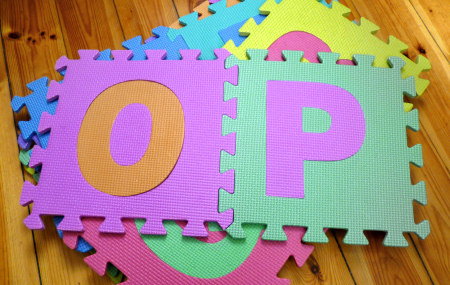
Foam floor mats (play mats)
Foam floor tiles or play mats for kids are identical to blocking mats. You can buy 2ft or 1ft square tiles in bright colours or serious grey, but I prefer the set of 12″ letter mats pictured above: with 26 interlocking mats I can arrange them into the shape of any crocheted piece I’m ever likely to make. Wait for a sale and you can pick up a set for under $10 – they may look a bit unprofessional, but you get far more blocking area than in an ‘official’ set of blocking mats, for far less money.
UPDATED 22 Mar 2013: Please read my warning about colour transfer if you use these mats!
Blocking is Key
Next time you’re crocheting lace, don’t worry if it looks less than encouraging while you’re crocheting – that is just part of the magic of lace! You can stretch it out between your hands to give you a temporary idea of how the finished stitch pattern will look after blocking. It’s always worth blocking your finished work to make it look its best, even if you use an acrylic yarn:

My Climbing Eyelets Triangular Shawl is 100% acrylic fingering weight, and, although the effect isn’t as dramatic as with the laceweight alpaca, blocking it still made a big difference. And, a year and a lot of use later, my shawl still looks just as good as the ‘after’ photo.
After all the effort you’ve put into crocheting a beautiful lacy piece, don’t skimp on that one last day waiting for your blocked piece to dry – it’s well worth it to turn your work from okay-looking to spectacular!
Ready to try making and blocking some crocheted lace? How about joining the PlanetJune Accessories Crochet-Along (on Ravelry)? The CAL runs until the end of the year, so you still have plenty of time 🙂
















Sue said
Wow! Thank you so much. I have been crocheting for awhile. Nothing fancy, but I did make a shawl once, and had I seen this I would have done it. I now know.for future items. Thank you! Sue
Jodi said
Oh, these are great ideas! I do my blocking by pinning into a towel on the (carpeted) floor and I haaate it, I keep looking longingly at the proper equipment online. I’m going to keep my eyes peeled for the bargain versions now! 😀
jackie westfall said
For doilies and other small pieces I have used my husbands archery target.
val said
its official, I am a non blocking slug! In my defense, I used to block all the time but haven’t made anything block-worthy in a while. Your tutorial makes me want to though..as do those blocking wires. Genius, pure and simple!
maura said
thank you for an excellent post, learned a lot. however i still have one question. after you’ve completed your projected and the blocking, does it have to be done every time the item gets laundered? if i am giving a shawl as a gift do i need to include blocking instructions? that’s probably a dumb question, but I still need to know????
June said
There are no dumb questions! Yes, you’d need to reblock it after laundering it. It’s a good idea to give care instructions with handknits anyway (hand-crochets isn’t a word, but I mean that too, obviously) as many yarns have special instructions (handwash, wash in cool water, air-dry, do not iron, etc) – check the label on your yarn for care instructions, and then add any additional instructions specific to what you’ve made, e.g. blocking and/or drying flat.
Cal said
When this article went up, my first thought was “Oh, that’s nice, but I’ll never use this.” And then just today I found a pattern that NEEDS wet blocking. Thanks, June!
Marie/Underground Crafter said
Hahaha, I thought I was the only person using kids play mats for blocking :). Thanks for sharing the tutorial.
Stocki said
Hi… great tutorial…thanks! I did one recently on spray blocking too… and I use a huge slab of left-over wall insulation or thick cardboard from a large box… both free too! If you are interested it’s on my blog :)x
Lee said
this is fantastic. I’ve always used a spray bottle, but this seems to be even better. I can’t believe the difference in the before and after photos. So you can use this with acyrlics as well? I’d always thought wet blocking was only for natural fibers, but apparently not. 🙂
June said
Yes, it’s not as effective as with natural fibres, but it really does help for acrylics too – I even used it to block my chunky acrylic rug! It took forever to dry (even after the very important rolling-it-up-in-a-towel step) but I do find that soaking any fibre all the way through works much better than just spraying the surface. My rug is still nice and flat a year later too 🙂
Lee said
really great tutorial– thanks, June. I’d love to see the rug you made, too! 🙂
June said
There should be a link in my last comment – let’s try that again: link to rug!
Swirls and Sprinkles said
Very informative! I have never blocked my projects, but with your tips, I am going to attempt it for the first time. I am working on something that would look so much better blocked. I just always found it intimidating.
Would you mind if I shared this post on my crochet blog?
Thanks for sharing!!
June said
Of course you may! I’m always very happy for people to share links to my posts – no need to even ask 🙂
Diana said
Thank you so much for this article. It is very thorough. I have those exact kids’ mats and never thought of using them for blocking. I hope you don’t mind if I share on my FB page. Great info!
June said
Please do, Diana!
Nikki said
So, I’ve never really blocked anything before, and I only started crochet because of amigurumi. I was wondering, as I tend to always have a slight misshapement of my pieces, if you blocked amigurumi? It doesn’t make any sense to me based on this post, or your website, but I thought I’d ask anyways, as I’ve gone through multiple websites looking at how to get the piece as close as you can to the original based on their pattern and I still don’t get similar shapes (though I haven’t tried the eye/muzzle placement from you, I tend to have a slightly misshapen head in the first place)
Sorry if this question is extremely bad. -/////-
June said
Nikki, there are no bad questions! You’re right, though, that you don’t block amigurumi. Anything worked in the round would need to be blocked over a rounded form to give it the correct rounded shape (e.g. to block a hat you’d need something like a foam head or balloon of the right size).
Without seeing your work, I can’t advise if/where you may be going wrong. It could be one of many things: crocheting inside out, working too loosely, crocheting into the wrong loops, misreading the pattern, stuffing insufficiently or too much… or something else entirely! I’d recommend my tutorials for help, but it sounds like you already know about them 🙂
If you’re having difficulties making any of my patterns, you’re always very welcome to ask for help in my ravelry group, or email photos to me directly so I can advise on what (if anything) you could do differently to make your ami look more like mine 🙂
Gail said
Thank you so much for an excellent article. I have wondered about the need for blocking, now I understand when to block. Love the suggestions on the “hardware” for making blocking easier. I am sharing this with all my fiber friends.